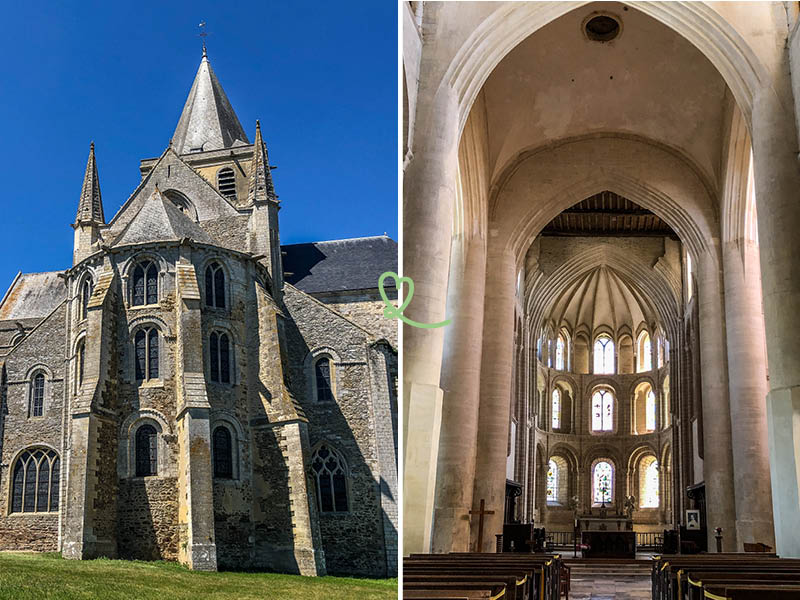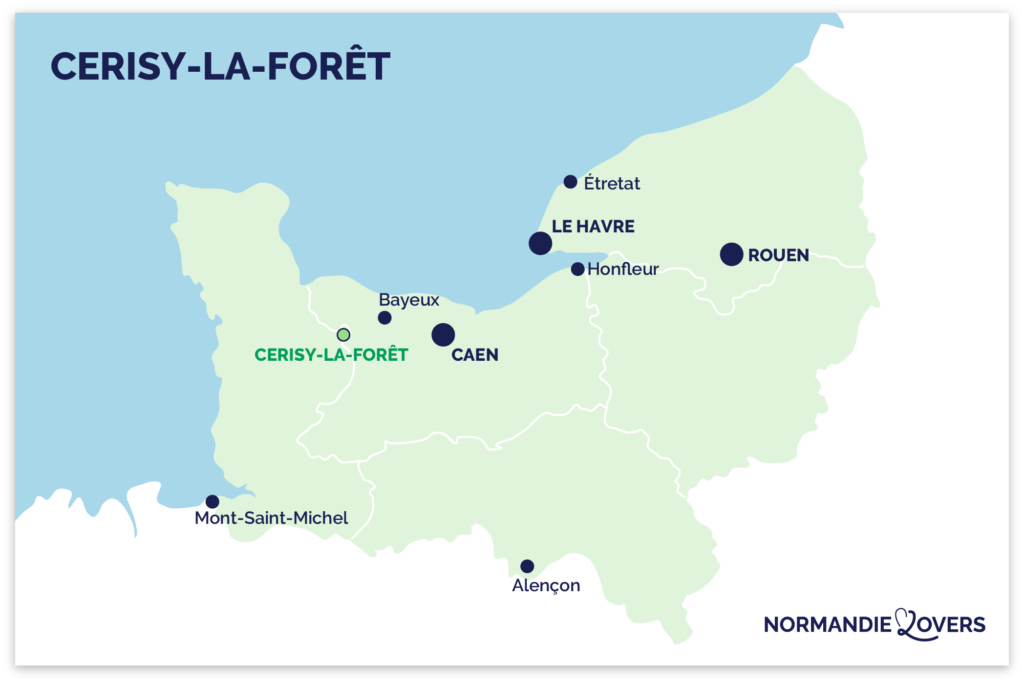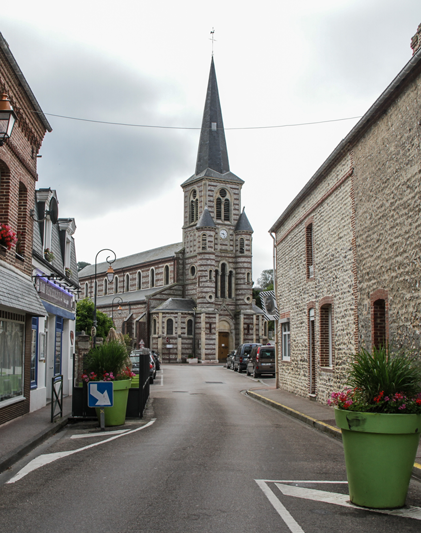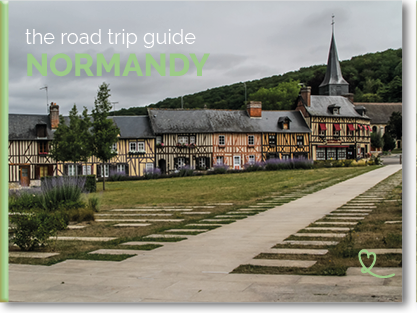If you’re planning a trip to Normandy, don’t miss the Abbaye Saint-Vigor. Situated on the edge of the Forêt de Cerisy, it embodies centuries of history, spirituality and architecture. Founded in the 11th century, the abbey was a flourishing intellectual and spiritual center. Despite the ravages of time and conflict, many of the original buildings still stand today. They gave us a fascinating insight into medieval monastic life.
In this article, you’ll find some useful tips to help you prepare for your visit and have a wonderful time!

This guide is completely independent, based on our experiences. We visited the region anonymously, making our own choices and paying our bills in full.
Why visit Saint-Vigor Abbey in Cerisy-la-Forêt?
Is Cerisy-la-Forêt Abbey worth it? Our opinion:
Yes, Cerisy Abbey is well worth a visit. In fact, we’ve included it in our selection of the most beautiful abbeys in Normandy, for several reasons:
- Its fascinating history dates back to the 6th century, when Vigor, then Bishop of Bayeux, had a monastery built. It was destroyed during Viking raids in the 9th and 10th centuries. It wasn’t until the end of the 11th century that the abbey church, dedicated to Saint-Vigor, was built.
- Its unique architecture: A major example of Norman Romanesque architecture, we learned that it served as a model for the construction of many of England’s churches after the Conquest. The three-storey apse, pierced by fifteen windows, is unique in the world and lends the monument exceptional power.
- Saint-Gerbold’s Chapel: located above the abbey’s entrance porch, the abbot’s chapel is a late 13th-century Gothic construction. It is reminiscent in scale of the Sainte-Chapelle in Paris, and features 15th-century painted decorations.

Why is Cerisy-la-Forêt famous?
Cerisy Abbey is famous asone of the oldest and most important abbeys in Normandy. As a spiritual, intellectual and economic center, it played an important role in the region’s medieval history.
It was also a royal abbey. This means that she was under the protection of the King of France and benefited from his gifts and favors. It has welcomed several of them in the course of its history (Henri II, Henri IV, Louis XVIII, among others). They stayed there when they travelled to Normandy.
Its remarkable architecture also contributes to its reputation. We were very impressed by its 3-level elevation and the 15 windows in its apse, making it a unique monument of unrivalled luminosity. Theabbey church has been listed as a Monument Historique since 1840, making it one of the first buildings to be recognized as part of France’s national heritage. Find out more here.

Our favorite moments
The weather was glorious during our visit and we were able to take full advantage of the site.
- From the outside, we loved the abbey’sNorman Romanesque architecture, with its enormous volumes and tall lantern tower dominating the transept. The whole is particularly imposing, giving the monument exceptional power.
- Whether admired from the outside or inside, the3-level apse is unique. We were captivated by the clarity it brings to the interior space. The atmosphere is particularly conducive to meditation and prayer.
- Finally, the 13th-century Chapelle Saint-Gerbold, also known as the Abbot’s Chapel, is a marvel of Norman Gothic art. We particularly liked the access to the chapel via its richly decorated loggia.

History in brief
Around 510, the hermit Vigor, future bishop of Bayeux, founded the primitive abbey, probably on the remains of a Druid temple. From the early 9th century onwards, it came under attack from Viking raiders. Plundered and finally destroyed, it wasn’t until the early 11th century that a new abbey was built, under the leadership of William the Conqueror and his father.
It became a royal abbey in the 13th century. Numerous royal endowments enabled major works to be carried out, including the construction of the Abbot’s Chapel. Various congregations succeeded one another within the walls of the abbey, which survived, not without damage, the 100 Years’ War and the War of Religions.
It was finally dismantled during the French Revolution, which drove out the last 7 monks. In 1840, the abbey was listed as a Monument Historique, and restoration work began after the Second World War.

WHERE TO STAY IN Normandy
We particularly appreciate staying in Normandy:
- Bayeux – our hotels selection
- Honfleur – our hotel selection

For more ideas, take a look at our article on the best places to stay in Normandy.
And if you already have an idea, take a look at our selections:
Access and map: Abbaye Saint-Vigor, Cerisy-la-Forêt
Where is Cerisy-la-Forêt Abbey?
- On the edge of the village of Cerizy-la-Forêt, in the Manche department
- West of Bayeux and halfway between Bayeux and Saint-Lô
- Driving time from Bayeux: 25min approx.
- Driving time from Saint-Lô: 20min approx.
- Driving time from Caen: 45min approx.
- Here is a map to help you find your way:

How to get there?
The village of Cerisy is isolated and your options for getting there are very limited. If you’re planning to visit Saint-Vigor Abbey, we advise you to go by car. Click here for directions.

OUR ADVICE FOR RENTING A CAR IN Normandy
- Compare prices on our preferred platform: DiscoverCars – one of the best rated sites.
- Choose a car that is comfortable enough (distances can be long) but compact (some parking lots and villages are narrow).
- Think of thecomplete insurance (some roads are tortuous and narrow).
- There is a lot of demand, book it early.

Parking
Free parking is available at the entrance to the site, along the abbey outbuildings, just opposite the entrance to the cemetery. Since our visit, it has been paved.

Useful tips: duration, schedules, eating…
Best time to visit
We visited Cerisy Abbey in the middle of summer and really enjoyed the freshness of its mature trees. But the colors of autumn are also magnificent, with the forest nearby, and springs in Normandy can also be delicious.
- Cerisy-la-Forêt Abbey is closed for the winter season, from early November to early April. More info on opening dates here.
- The abbey church is not open to visitors during religious ceremonies. See the spiritual program here.

Length of visit and main difficulties
Allow 1 hour to visit the site, and perhaps a little more if you want to enjoy the park, stroll around the lake and continue your walk to the Sculpture Park behind the cemetery. Find out more here.
The paths around the abbey were gravelled at the time of our visit, but it remains accessible to people with reduced mobility, who can visit the abbey church. However, the staircase in the loggia of the Chapelle Saint-Gerbold does not allow them to enter.

Advice on how to visit
There’s no set direction, and you’re free to explore the site as you please. As we entered the site, we were shown a film about the abbey. We then walked along the Chapelle de l’Abbé to tour theabbey church and take in its imposing architecture, before discovering the interior. We ended our visit with a tour of the chapel.

USE OUR GUIDE TO PLAN A
DREAM TRIP TO Normandy
All the information you need for your trip:
- 8 maps that make planning easier
- 160+ pre-selected locations
- Practical advice
- 300+ photos to help you choose

Visiting with children
There are several possibilities for young audiences:
- They can download a free quiz from the abbey’s official website. It’s a fun way to discover the little secrets of Saint-Vigor de Cerisy-La-Forêt Abbey. It is available in English and French. Find out more here.
- They’ll love the Cerisy-la-Forêt Sculpture Park. This is an artistic space below the cemetery where visitors can wander through a collection ofcontemporary works in the open air. It’s a place where art meets nature, a dialogue between artworks and the surrounding landscape. Find out more here.
- At last, treasure hunters beware! As part of the Association des Abbayes de Normandie’s partnership with the Geocatching website, Saint-Vigor Abbey is offering a new tour route: Saint-Vigor Abbey through the ages. Find out more here.

Schedules and rates
The abbey is open:
- April: daily, 11 a.m. to 6 p.m., except Mondays
- May, June, July and August: daily, 10 a.m. to 6 p.m.
- September: daily, 11 a.m. to 6 p.m.
- October: Saturdays and Sundays, from 12pm to 6pm.
Full price: €6
Children under 12 free of charge
Check out the latest rates and the complete list of discount beneficiarieshere.

Guided tours
Guided tours are available:
- every Wednesday, 3 p.m. from May to September
- every Friday, 10:30 a.m. in July and August
Reservations are highly recommended here.

Catering
The village of Cerisy-la-Forêt, less than 500m from the abbey, has a few restaurants, including a highly-rated crêperie and an Irish pub (open in the evenings), but we didn’t try them out.
Subscribe to our Newsletter
- Get away from it all with Region Lovers’ beautiful destinations!
- Once a month
- Advertising-free
Start of tour: around Saint-Vigor Abbey Church
When we arrived on the outskirts of Saint-Vigor Abbey, our first impression was of the huge park, with the Etang aux Moines reflecting the buildings. But what intrigued us most as soon as we entered was the abbey’s blind facade to the west, and the austerity of the transept on the south side.
The blind façade and austere south transept
The blind facade of the abbey church
This is the facade in front of you from the parking lot. It’s actually a partition that once separated parishioners from monks. It allowed the latter to celebrate mass without crossing paths with the former. The bays reserved for parishioners were demolished in the early 19th century, leaving this blind partition as a new façade, which piqued our curiosity.

The austerity of the transept
Once past the entrance porch, the imposing mass of the transept with its 3 high windows can be seen on the left, on the south side. She made a big impression on us. Especially as it is topped by the massive, square silhouette of the lantern tower. The whole perfectly expresses the building’s overwhelming religious authority.

The richness of the eastern chevet
As we walked around the building, we were surprised by the many architectural details of the east-facing chevet. They contrast with the sobriety of the south façade.
The 3 levels of the apse
The apse has 3 levels of bays that particularly caught our eye. In fact, this is the only layout of its kind in Romanesque art anywhere in the world. The apse was reinforced in the 14thcentury . The reinforcement buttresses are clearly visible. Some high windows have been modified in Gothic style.

The flamboyant style of the apsidal openings and the chartrier
On either side of the chevet, we particularly appreciated the 2-storey absidioles with their wide, flamboyant-style openings. The circular chartrier on the south side also features 15th-century windows.

The 2 bell towers of the gable
On either side of the apse gable, we particularly liked the slender silhouettes of the 2 bell towers, as well as the series of Romanesque-style gargoyles and modillions around the chevet roofs.

Continuation of the tour: inside the Abbey Church of Saint-Vigor
As we entered the abbey church, we were immediately enveloped by the solemn atmosphere of the place, where architectural power offers a deeply immersive experience.
The nave of the abbey church is renowned for its generous dimensions, creating an impression of space and grandeur. Built to a Benedictine plan, it comprises 3 elevations: arcades, tribunes and high windows with their gallery. Its vast proportions create a particularly majestic atmosphere that had us spellbound.

The 40m long transept
The dimensions of the transept of Cerisy Abbey Church make it the largest Romanesque church in Normandy. The north arm of the transept was rebuilt in the 18th century, but the south arm is original. We really liked the flat, framed ceiling above the grandstand.

The 15 windows of the apse
With its 15 Romanesque windows on 3 levels and its courières on the upper 2 levels, the magnificent apse of the Abbey Church of Saint-Vigor is unique. Facing east, these openings provide abundant light from the choir. The apse immediately catches the visitor’s eye, and we spent a long time contemplating it, almost hypnotized by such beauty.

Raising the choir
The choir of the abbey church is also on 3 levels. We really enjoyed the 40 wooden stalls on the first level. They are the oldest stalls in Normandy. Above, you can see the large paired bays on the second level, followed by the small triple bays with windows on the third, which bring a little light into the shadow of the choir.

End of visit: convent buildings and gatehouse
As we made our way out of the site, we visited what remains of the convent buildings and gatehouse, as well as the Abbot’s Chapel, which enchanted us.
Saint-Gerbold’s chapel and loggia
The chapel is a little marvel. It is reminiscent in scale of the Sainte-Chapelle in Paris, and features 15th-century painted decorations. It was built thanks to a gift from Saint-Louis, who was on his way to Mont-Saint-Michel. We loved the access staircase and its loggia-shaped landing, richly decorated with capitals and a rose window.

The chapel is rectangular in plan. At the end, on the south side, the3-sided apse is spectacular. It is lit by high windows. Its vaults are adorned with keys decorated with coats of arms. We recognized the lilies of the Capetian monarchy and the Norman leopards.

The Hall of Justice
A wooden staircase separates the chapel from the 13th-century Salle de Justice. By papal decree, the abbot had the right of high and low justice. He also made administrative decisions concerning the abbey’s many properties. The room now houses the monks’ furniture, documents and manuscripts. On the ceiling, we noticed the famous scales, symbolizing justice.

The remains of the towers, the underground passages and the lapidary museum
To the south of the chapel, the remains of the towers can be seen on the south façade, with its buttresses and double-glazed windows. We learned that a network of underground passages leads to the monk’s pond, the forest and a nearby farm, but we weren’t able to visit them. Finally, in the chapel’s lower hall, a lapidary museum houses fragments of statues and a collection of decorated pavements.

Frequently asked questions
What is Les Médiévales de Cerisy-la-Forêt?
Overa summer weekend, the Médiévales de Cerisy-la-Forêt showcase medieval history in Normandy, with historical re-enactments, street performances, demonstrations of traditional crafts and entertainment… An immersion in medieval life in an authentic setting for the whole family. A unique opportunity to discover and celebrate Cerisy-la-Forêt’s rich cultural and historical heritage. Find out more here.

What other abbeys are there in Normandy?
There are over 40 abbeys in Normandy, the most famous of which is Mont-Saint-Michel. But there are also the abbeys of Jumièges, Hambye, Saint-Georges de Boscherville, Lucerne, Caen, Mortemer, Saint-Pierre-sur-Dives, Saint-Wandrille… and many others. More abbeys here.

What else is there to do in the area?
Cerisy Abbey is a 25-minute drive from Bayeux, and there’s plenty to see and do in the surrounding area. It’s an excellent starting point for visiting must-see sites such as Mont-Saint-Michel (there it is again!), the D-Day landing beaches, the Château de Balleroy and many other historical and natural sites. Not to mention the gastronomic delights of the region. In fact, we’ve devoted an article to our top 10 excursions around Bayeux.

PLAN YOUR TRIP TO Normandy
Inspiration destinations
- Deciding where to go in Normandy – the best destinations
- Our weekend ideas: best-of, romantic, unusual, seaside, luxury, family
- 16 seaside hotels in Normandy
- The most beautiful charming hotels in Normandy

Best of

Practice
- Where to stay in Normandy – best places and hotels
- See our tips for renting a car at CDG airport, Orly airport, Beauvais airport, Caen, Rouen, Bayeux…






